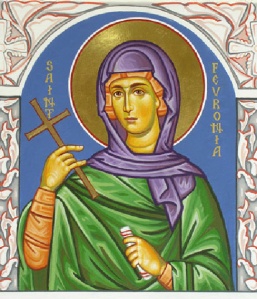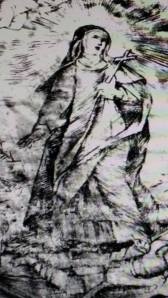 From distant Mesopotamia comes the story of St. Febronia the Holy Martyr. Ever since the seventh century Eastern Orthodox Christianity has commemorated her on June 25. This is her feast day.
From distant Mesopotamia comes the story of St. Febronia the Holy Martyr. Ever since the seventh century Eastern Orthodox Christianity has commemorated her on June 25. This is her feast day.
What I tell you about Febronia is based on a biography written thirteen hundred years ago by a nun named Thomais. Composed originally in Syriac, this life enjoyed immense popularity and survives in Greek, Latin, Arabic, Armenian, and Georgian translations. I read the Greek and Latin versions.
St. Febronia was born in the ancient land that lies between the Euphrates and Tigris Rivers. When she was only two years old, her parents entrusted her to the care of a relative, Bryaina, the abbess of a convent. The aunt reared her niece strictly, according to the severe monastic discipline of soul and body.
Febronia proved to be a perfect pupil, intelligent, studious, and devout. By the time of her middle teens she had become a young woman of dazzling physical and spiritual beauty, and a charismatic teacher with a reputation for wisdom. She not only expounded the Scriptures to her sister nuns. The great ladies of the town also came to the convent, eager to learn from the beautiful young nun.
Febronia’s life was short. At age eighteen she was martyred. That is, she gave her life in witness for her faith. About 304 A.D. the Roman Emperor Diocletian dispatched officials and soldiers to rid Mesopotamia of Christians.
To escape persecution and death the Christian population of Nisibis fled, including the bishop and clergy. Except for Febronia, her aunt, and another elderly nun, the other nuns of the convent joined the flight to safety. Thus when the soldiers broke into the convent, they found only three nuns. The two aged nuns were not harmed, but Febronia was carried away in chains to face interrogation and punishment.
Rejecting bribes, flattery, and threats, gladly submitting to cruel tortures, the young woman refused to deny her Christian faith. On June 25 Febronia was beheaded. Her body was found and buried in the convent. Soon her tomb became a place of miraculous healings. From Nisibis, where later a church in her honor was built, the story of Febronia’s heroic martyrdom spread throughout the East, reaching as far south as Ethiopia and as far west as Italy. In Constantinople patriarchs eulogized this woman martyr. Hymnographers sang the praises of Febronia “full of wisdom.”
 Febronia represents a type of saint, the virgin martyr. Numbering hundreds, even thousands, the catalog of women saints includes not only the virgin martyr, but many other types as well. In the liturgical calendar of Orthodox Christendom are listed women saints who were disciples of Christ, apostles, evangelists, confessors, deacons, prophets, ascetics, builders of churches and convents. Generally ignored by a male-dominated church, this well documented record of women’s services and sacrifices to the church from its earliest beginnings nevertheless constitutes an illustrious chapter in the long history of Eastern Christianity.
Febronia represents a type of saint, the virgin martyr. Numbering hundreds, even thousands, the catalog of women saints includes not only the virgin martyr, but many other types as well. In the liturgical calendar of Orthodox Christendom are listed women saints who were disciples of Christ, apostles, evangelists, confessors, deacons, prophets, ascetics, builders of churches and convents. Generally ignored by a male-dominated church, this well documented record of women’s services and sacrifices to the church from its earliest beginnings nevertheless constitutes an illustrious chapter in the long history of Eastern Christianity.
These glorious women saints notwithstanding, the church has not yet accepted women as equal members in the body of Christ. For too long the church has forgotten that women also are created in the divine image and likeness (Genesis 1:27) and that among those who are baptized into Christ “there is neither male nor female” (Galatians 3:28). Equal to men in their love of God, which they have repeatedly proved by their piety and martyrdom, women remain unequal in the church, excluded from leadership and denied access to the altar.
Behind this discrimination lies an ancient entrenched tradition of patriarchal prejudice against women. Because this tradition has been sanctified by a theology based on the belief that women’s inferiority and subordination to men are divinely ordained, this prejudice survives to this day. Brilliant theologians and hierarchs, all men, created this theology in the first Christian centuries. Although influential church fathers knew and sometimes quoted Genesis1:27 and Galatians 3:28, they were never guided by these scriptural affirmations of women’s dignity and equality. Instead, they imposed on the church the patriarchal customs and laws prevailing in the cultures of the Eastern Mediterranean.
The church fathers justified the oppressive structures against women outside and inside the church by appeals to the authority of St. Paul and by sexist interpretations of selected scriptural texts. Although Christ extended freedom and equality to both sexes, the church fathers both in the East and in the West denied them to the daughters of Eve. Speaking for all the founding fathers, St. Cyril of Alexandria declared in the fifth century that “the male must always rule and female everywhere must be in second class.” Fifteen hundred years later this rule remains operative.
To rationalize woman’s oppression in society and church the fathers of Christianity developed a totally negative image of women. This anti-woman theology received classic expression in the golden eloquence of St. John Chrysostom. Christendom’s greatest preacher characterized women as stupid, softer than wax, vain, compulsively garrulous, fickle, slow of comprehension and servile in mentality. God had made them, he proclaimed, fit only for the domestic sphere.
By fulfilling their “special” role in the confined private sphere of the home, they freed their male relatives for significant public activities in the church and state. When Chrysostom made such statements he maligned the sex of saints and of his best friends, the women who like Olympias, deacon of Hagia Sophia, never deserted him. None of the fathers ever doubted that their own sex was superior to the other.
No church father hesitated to pronounce all women physically, morally, and intellectually inferior to men. Their presumably innate inferiority necessitated women’s submission to the superior sex, in all spheres barring none. In the church she was sentenced to silence, forbidden to teach and to serve God at the altar. When the nun named Theodosia was caught preaching and teaching, she was told, “It happens that your body makes you a woman, whether you like it or not. So stop teaching men in the church. For the Apostle (Paul) made it clear that this is shameful …”
These brief remarks suffice to suggest what obstacles confront the Orthodox woman or man who wishes change in the status of women in my church. Of all Christian churches it is the Orthodox Church that most tenaciously clings to ancient traditions. Yet, if women are to acquire equal dignity in the church this two-thousand-year-old tradition of discrimination against women must be examined and reassessed.
Above all, woman’s traditional second-class status needs to be reconsidered in the light of Christ’s own affirmation of women. The Gospels all record how he broke the customs, laws, and taboos of His time and culture in order to confirm woman’s divine image. Nowhere is this proved more dramatically than by his healing of the woman with the 12-year hemorrhage; his conversation with the Samaritan woman by the well; by his choice of a woman, Mary Magdalene, to be the first apostle of the Resurrection. It is worth noting that Orthodox tradition acknowledges Mary Magdalene to be the “first apostle,” and “the apostle to the apostles,” and the “first evangelist.”
Surely the church ought to follow the example of her founder rather than to continue the tradition of patriarchal prejudice against women. For too long it has prevented women from taking their rightful place beside their brothers in the new creation.
Furthermore, it should also be recalled that in the apostolic church there was no discrimination between male and female. Evidence from the Book of Acts and the genuine epistles of St. Paul indicates that indeed women participated fully in the liturgical life of the primitive church and that they held positions of leadership.
To return again to St. Febronia, our meditation on Febronia the Holy Martyr would have been neither complete nor honest without a reflection on the status of her sisters in the church, yesterday and today.
Words of praise and honor to women saints will remain hollow and meaningless until women are restored to equal dignity in Christ’s church on earth.
Given at the Common Council meeting of Church Women United,
June 25, 1983, Stony Point, New York.





